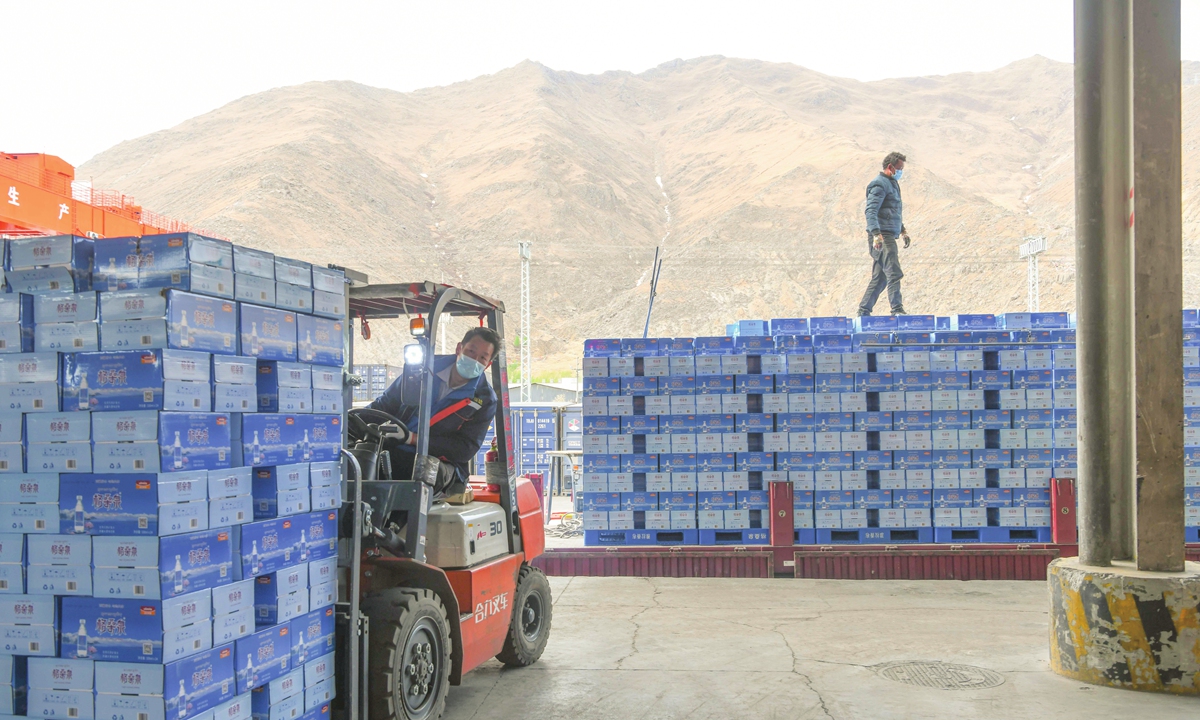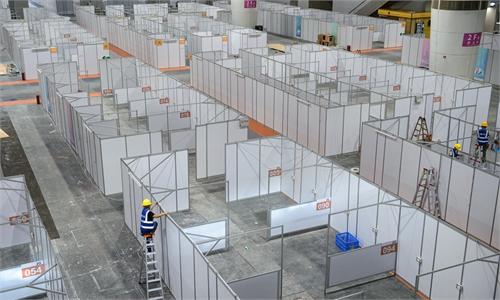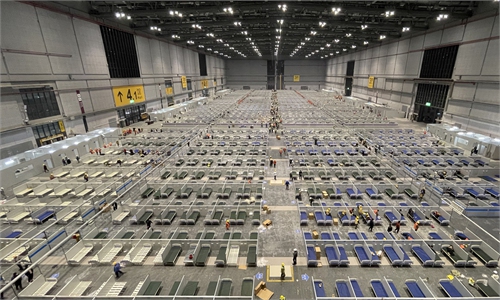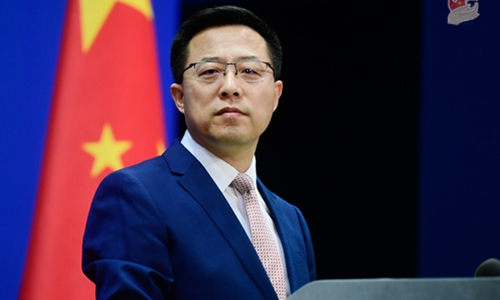China doubles down on efforts to unclog transport and logistics arteries
Dynamic zero-COVID policy continues alongside push for functioning economy

Workers load daily necessities at Lhasa Railway Station on April 10, 2022. The materials are contributed by the people of Xizang (Tibet) Autonomous Region to support Shanghai and Jilin Province which are fighting against the COVID-19 epidemic. Photo: VCG
Agencies across the Chinese central government are doubling down on efforts to unclog transport and logistics, the "arteries" of the world's second-largest economy as the country remains unwavering in its arduous yet trailblazing two-pronged pursuit of dynamic zero-COVID while pushing for supply chain resilience as part of a functioning economy.
The latest moves include fresh vows on Tuesday from the National Development and Reform Commission (NDRC) and the Ministry of Commerce (MOFCOM) to ensure the last kilometer and even the last 100 meters of delivery are working well for everyday supplies to be readily shipped to virus-hit regions.
Such commitments, adding to a slew of weighty policy announcements over recent days, are envisioned to troubleshoot logistics artery blockages that have lately weighed on economic activities, industry insiders said.
The swift official response to virus-inflicted transport and logistics hiccups is also considered to continue showing China's supply chain strength, effectively convincing those sowing the seeds of doubt over the country's virus containment strategy of a workable balance between dynamic zero-COVID and economic viability.
Greater unclogging efforts
At a Tuesday media briefing held by the the joint prevention and control mechanism of the State Council, the country's cabinet, Xu Zhengbin, an NDRC official, said that the economic planning agency would strengthen production organization and market supplies, and strive to coordinate and urge relevant local authorities to smooth out the last kilometer and last 100 meters of delivery, thereby guaranteeing life supplies to virus-affected areas.
In similar remarks to the briefing, Li Danghui, an official with MOFCOM, disclosed that Shanghai has been guided to set up contactless transfer stations in its neighboring areas for daily necessities to be transported across regions while reducing virus transmission risks.
Elaborating on the commerce ministry's supply-ensuring efforts in complementing the State Council's call for smooth freight transport, Commerce Minister Wang Wentao also convened a special meeting on Monday, according to a meeting readout on MOFCOM's website on Tuesday.
Presently, three contactless transfer facilities have been built in Kunshan, East China's Jiangsu Province, Pinghu, East China's Zhejiang Province, and in the western suburbs of Shanghai, finalizing transfers of 2,599 tons of supplies, per the readout.
In addition to the official avowals, the Ministry of Transport, together with four other agencies including the National Railway Administration and the Civil Aviation Administration of China, unveiled guidelines to accelerate the development of cold chain logistics, according to a statement on the central government's website on Tuesday.
The guidelines aim to support eligible county-level logistics centers and transport services stations at township levels in exploring cold chain service functionalities so as to improve the initial one kilometer of cold chain facilities at the origins of farm produce.
Meanwhile, fresh food e-commerce platforms and logistics firms are encouraged to ramp up commitments to improving the last kilometer of urban cold chain facilities with the equipment of smart cold chain self-pickup cabinets in communities and commercial buildings.
With the newest moves to flesh out the country's swift action and concrete solutions to transport and logistics fragmentation as a steadfast approach to achieve zero-COVID being taken across the country, logistics industry insiders find their worries panned out.
A manager of a logistics company in Shanghai surnamed Zhao told the Global Times on Tuesday that many places had persuaded people to return to Shanghai but that truck drivers were not allowed to get off the highways after they arrived in Nanjing from Shanghai or between Shanghai to other neighboring cities.
"But since the central government issued a document to unclog logistics, including forbidding the shutdown of highways without permission, the business has eased to a great extent," Zhao said.
Blockage troubleshooting
As highway, road and waterway closures in some parts of the country are inevitably caused by virus prevention efforts, taking a toll on business operations and economic activities, the central government has quickly taken note of such artery blockages and come up with decisive measures to deal with the issue.
The State Council on Monday asked local governments to "make every effort" to ensure the smooth movement of freight through the logistics system amid epidemic controls, a clear response to regional actions that have caused growing disruptions to supply chains and trade flows.
Any shutdowns of highway services, port terminals, railway stations or airports without authorization are strictly forbidden, and stopping crew changes on international shipping services without authorization is not allowed, the cabinet said in a notice.
Later on Monday, Premier Li Keqiang asked for research on "greater efforts" to ensure the orderly operation of key transportation hubs such as ports, maintain smooth international and domestic logistics, and maintain the stability of industrial supply chains.
Before the government notice on Monday, trucks were stuck at highway intersections for two or three days, but now it is about six to eight hours. While there is still potential for improvement, the situation has largely eased compared to the past.
In addition, some places have put seals on truck cab doors at highway intersections in a bid to prevent infection, but making it impossible for drivers to exit their cabs, including going to the toilet. But now, it is more flexible with some other contingency measures, according to Zhao.
While supply chain hurdles have been largely relaxed, there are still some areas where logistics service providers are hoping will improve.
A manager with a logistics service company based in Ningbo, East China's Zhejiang Province surnamed Pan applauded the government's move to ease certain restrictions on the supply chain, and hopes that some other pressing issues can also be tackled soon to make it easier for them to do business.
"We hope that there will be more nucleic acid test spots for drivers, especially at the exits of highways, and the result of the test can be updated faster," she said.
There are many places requesting truck drivers to show the result of nucleic acid of 24-hour valid period, but the test results are not updated on a timely-basis, according to Pan.
The imperative push for smoother transport and logistics is also seen as echoing the country's call to build a unified national market.
The Communist Party of China Central Committee and the State Council on Sunday unveiled a guideline to accelerate the building of a unified national market, envisioning breaking local protection and market fragmentation and unblocking key sticking points that weigh on economic circulation as part of a wide-ranging push for an effectively regulated, fairly competitive and fully open market across the country.
As the guidelines stipulate, the country would strengthen the building of an emergency logistics system, improve transport facilities and logistics stations in high-risk areas in terms of disaster exposures, and avoid supply shortage risks in major products such as food and energy.
Convincing balance
With the expeditious solutions indicating a more sophisticated push for balancing the country's virus containment efforts and its economic functioning, hopes are high that those calling into question the zero-COVID strategy ought to be convinced of the country's capabilities of striking a compelling balance.
"China's dynamic zero-COVID policy and anti-epidemic protocols are based on science and expert opinions, and consistent with its national realities and the WHO's guiding principles," Foreign Ministry spokesperson Zhao Lijian told a regular media briefing on Tuesday.
"Naturally all prevention and control measures come at a price. All these efforts are worthwhile to protect people's life and health. Facts have proven that the overall guideline of dynamic zero-COVID is proper as it fits China's realities and has delivered desirable results," Zhao said.
He made the remarks in answer to claims by the European Union Chamber of Commerce in China that the zero-COVID approach has caused "significant disruptions" for many companies.
The numbers of confirmed cases and fatalities and the statistics of economic growth of China all point to the conclusion that China's COVID-19 containment is among the most successful in the world, according to the spokesperson.
By adopting robust and effective containment measures, China is able to maintain socioeconomic growth and, at the same time, make important contributions to keeping global supply chains stable and smooth and sustaining world economic growth, he continued.
Wang Hongwei, a professor at the Renmin University of China's School of Public Administration and Policy, told the Global Times on Tuesday the phenomenon of blocking the traffic, which was previously seen in the early Wuhan outbreak, breaks the country's epidemic policy of sticking to a balance between the epidemic fight and normal economic operations.
The normal operation of logistics is the basic to guarantee the epidemic-hit regions to have stable supply of necessities and ensure the normal operations of national economic activities, Wang added.
Wang argued against some local governments' behaviors of suspending traffic and cutting off logistics to avoid the spread of the epidemic even before it actually comes as sloppy administration.
To better avoid spread of Omicron along with logistics delivering, Wang suggested local governments should add extra anti-epidemic measures for drivers who deliver daily necessities such as increasing the frequency of nucleic acid testing and sample testing on goods.



